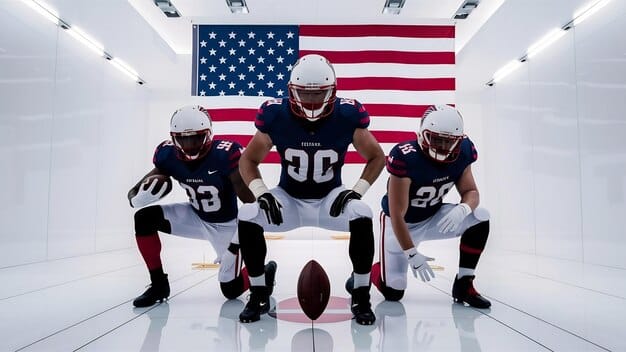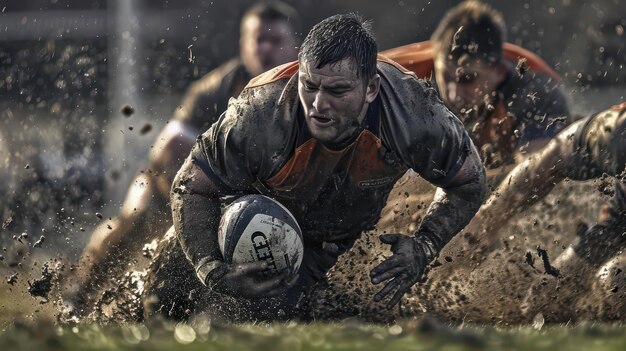World Cup 2026: US Team Starting Lineup Prediction Based on Player Performance

Predicting the US Team’s starting lineup for the World Cup 2026 involves analyzing current player performance, considering factors such as form, fitness, and tactical suitability. This article uses those factors to predict the starting lineup for the US team at the World Cup 2026.
The anticipation for the World Cup 2026, co-hosted by the United States, Canada, and Mexico, is already building. For US soccer fans, the question on everyone’s mind is: what will the USMNT’s starting lineup look like? Predicting the US Team’s Starting Lineup Based on Current Player Performance requires a deep dive into the current form, fitness, and tactical adaptability of the available players.
This article will analyze the potential candidates for each position, considering their recent performances and how they might fit into the team’s overall strategy for the World Cup 2026: Predicting the US Team’s Starting Lineup Based on Current Player Performance.
Analyzing Goalkeeper Options for World Cup 2026
The goalkeeper position is crucial, and the USMNT has several capable options. Evaluating these players involves looking at their shot-stopping ability, command of the area, and distribution skills. Who will be the man between the posts in 2026?
Potential Candidates for Goalkeeper
Several goalkeepers are vying for the starting spot. Here’s a closer look at some of the frontrunners:
- Matt Turner: Currently the first-choice keeper, Turner’s shot-stopping abilities are well-regarded.
- Zack Steffen: Once the presumed starter, Steffen needs consistent playing time to regain his form.
- Gaga Slonina: A young prospect with immense potential, Slonina could emerge as a contender.
The coaching staff will need to assess each player’s development and performance leading up to the tournament. This prediction of the USMNT’s starting lineup for the World Cup 2026 is still very fluid.

Defensive Lineup Predictions
The defense is the backbone of any successful team. For the USMNT, finding the right combination of center-backs and full-backs is essential. How will the defensive unit be structured for the World Cup 2026, considering the current player pool?
The defensive lineup requires both experience and athleticism. Here’s a possible configuration:
Possible Starting Defenders
Several players are in contention for a starting role in the defense:
- Antonee Robinson (Left-Back): Robinson’s pace and attacking prowess make him a key player.
- Chris Richards (Center-Back): Richards brings physicality and aerial ability to the defense.
- Miles Robinson (Center-Back): Robinson’s recovery from injury will be crucial, but he has the potential to be a starter.
- Sergiño Dest (Right-Back): Dest’s versatility and attacking contributions are valuable assets.
Other players, such as Joe Scally and Mark McKenzie, will also be in contention. The final decision will depend on form and tactical matchups, greatly impacting the World Cup 2026: Predicting the US Team’s Starting Lineup Based on Current Player Performance.
Midfield Dynamics and Key Players
The midfield is where games are often won or lost. What midfield trio will provide the creativity, control, and defensive support needed for the USMNT in the World Cup 2026? Identifying the right combination is a key task.
Midfield Options and Formations
The USMNT has a wealth of midfield talent. Here are some considerations:
A balanced midfield is essential for controlling tempo and winning battles.
- Tyler Adams: Adams’ defensive work rate and tackling ability are crucial.
- Weston McKennie: McKennie’s box-to-box energy and goal-scoring ability make him a vital asset.
- Yunus Musah: Musah’s dribbling and passing skills add creativity to the midfield.
Other players like Luca de la Torre and Gio Reyna offer different skill sets. The coach’s tactical preferences will play a significant role, and this will be a critical determinant for World Cup 2026: Predicting the US Team’s Starting Lineup Based on Current Player Performance.
Attacking Prowess: Who Leads the Line?
Goals win games, and the USMNT needs a reliable attacking force. Who will be the primary goal-scorers and playmakers in the World Cup 2026? Evaluating current form and potential partnerships is essential.
Forwards and Wingers to Watch
The attacking lineup is filled with potential. Key players include:
The attacking players need to be clinical and creative in the final third.
- Christian Pulisic: Pulisic’s dribbling and goal-scoring ability are essential for the USMNT.
- Folarin Balogun: Balogun’s clinical finishing could make him the starting striker.
- Tim Weah: Weah’s pace and versatility make him a valuable asset on the wing.
Players like Ricardo Pepi and Brenden Aaronson will also compete for spots. The attacking lineup will need to be dynamic and adaptable, which will inform the discussion around World Cup 2026: Predicting the US Team’s Starting Lineup Based on Current Player Performance.

Tactical Formations and Strategies
Tactical flexibility is crucial in modern soccer. What formations are most likely to be employed by the USMNT in the World Cup 2026? Understanding potential formations is key to predicting the starting lineup.
The tactical approach will depend on the opponent and the players available.
- 4-3-3 Formation: A balanced formation that allows for attacking width and midfield control.
- 4-2-3-1 Formation: A more defensive setup with a focus on counter-attacking.
- 3-5-2 Formation: This formation provides defensive solidity and attacking options through wing-backs.
Formations might vary depending on the opponent. All of these could factor into the final World Cup 2026: Predicting the US Team’s Starting Lineup Based on Current Player Performance.
The Road to 2026: Key Milestones and Preparations
The journey to the World Cup 2026 involves meticulous planning and preparation. What key milestones and friendly matches will shape the USMNT’s readiness for the tournament? Tracking these events is crucial for understanding team development.
Several key events will shape the team’s preparation.
- Friendly Matches: These games provide opportunities to experiment with different lineups and tactics.
- CONCACAF Competitions: These tournaments offer competitive matches and valuable experience.
These events will be pivotal in shaping the final roster. Overall, the World Cup 2026: Predicting the US Team’s Starting Lineup Based on Current Player Performance depends on these lead-up events.
| Key Aspect | Brief Description |
|---|---|
| ⚽ Goalkeeper Choice | Turner, Steffen, and Slonina contend for the starting role. |
| 🛡️ Defensive Lineup | Robinson, Richards, and Dest are vital defensive players. |
| 💪 Midfield Trio | Adams, McKennie, and Musah offer balance in midfield. |
| 🎯 Attacking Force | Pulisic, Balogun, and Weah lead the attacking lineup. |
Frequently Asked Questions
Currently, Matt Turner is the frontrunner due to his consistent performances and shot-stopping abilities. However, Zack Steffen and Gaga Slonina are also in contention and could challenge for the spot with strong performances this season in the lead-up to the World Cup 2026: Predicting the US Team’s Starting Lineup Based on Current Player Performance.
Antonee Robinson, Chris Richards, and Sergiño Dest are strong contenders. Miles Robinson’s recovery from injury will also be a key factor in determining the final defensive composition. Other players are competing for a spot.
A midfield of Tyler Adams, Weston McKennie, and Yunus Musah is expected to provide a good balance of defensive stability, energy, and creativity. Other combinations will be considered, which affects the World Cup 2026: Predicting the US Team’s Starting Lineup Based on Current Player Performance.
Christian Pulisic, Folarin Balogun, and Tim Weah are the key forwards expected to lead the attack and provide the scoring threat. Their individual performances and tactical fit will be closely monitored for the USMNT Team.
The USMNT might employ formations such as the 4-3-3, 4-2-3-1, and 3-5-2, depending on the opponent and the tactical approach. The final decisions will shape the World Cup 2026: Predicting the US Team’s Starting Lineup Based on Current Player Performance.
Conclusion
Predicting the USMNT’s starting lineup for the World Cup 2026 is a dynamic process influenced by current player performance, tactical considerations, and ongoing preparations. The final selection will aim to create a balanced and competitive team capable of making a significant impact on home soil.





